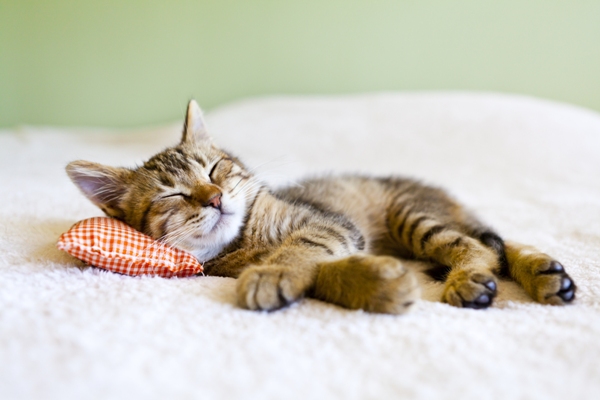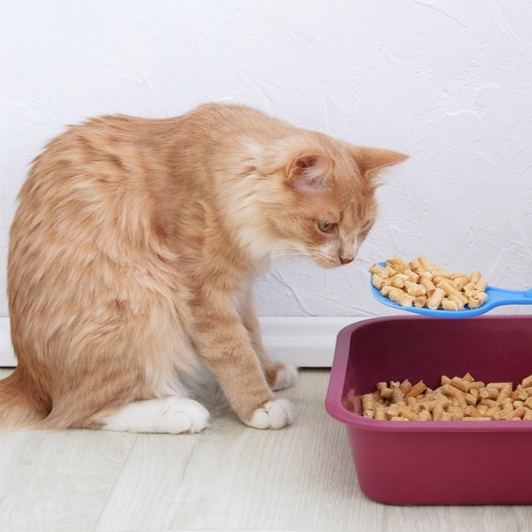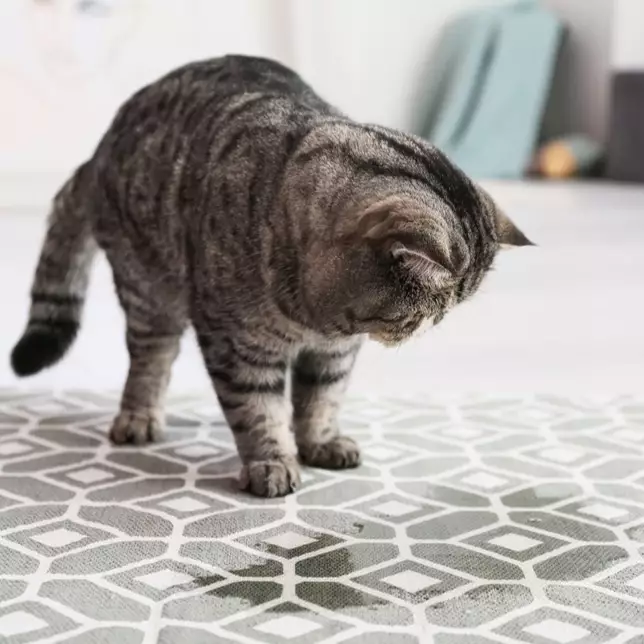Keratoconjunctivis sicca (KCS) in cats
What is keratoconjuctivis sicca (KCS)?
Keratoconjunctivis sicca (KCS) is an eye disease that is also commonly referred to as “dry eye.” KCS is an inflammation of the cornea, which is the clear, transparent front of the eye, and the conjunctiva, which is the delicate membrane lining the eye, brought about by dryness of the eye.
Tears are essential for eye health; they lubricate the cornea and remove any debris or infectious agents that may contact the eye. The tear film is a mixture of mucus, fatty liquid and water. The watery (aqueous) component of tears is produced by the lacrimal glands situated above the eye in the cat’s third eyelid. KCS, or dry eye, is characterised by a deficiency in the aqueous layer of the tear film over the surface of the eye and in the lining of the lids. This deficiency results in adverse changes in the eye, in particular dryness, inflammation and irritation to the surface of the cornea, which cause the cat discomfort and pain.
The lack of aqueous tear film over the cornea also deprives the cornea of oxygen and nourishment, which can lead to scarring and subsequent loss of vision. The eye tries to compensate for the lack of aqueous tear film by producing more mucous. If left untreated, KCS will result in eyes which have a thick oily mucus layer over their surface. In most cases, both eyes are affected.
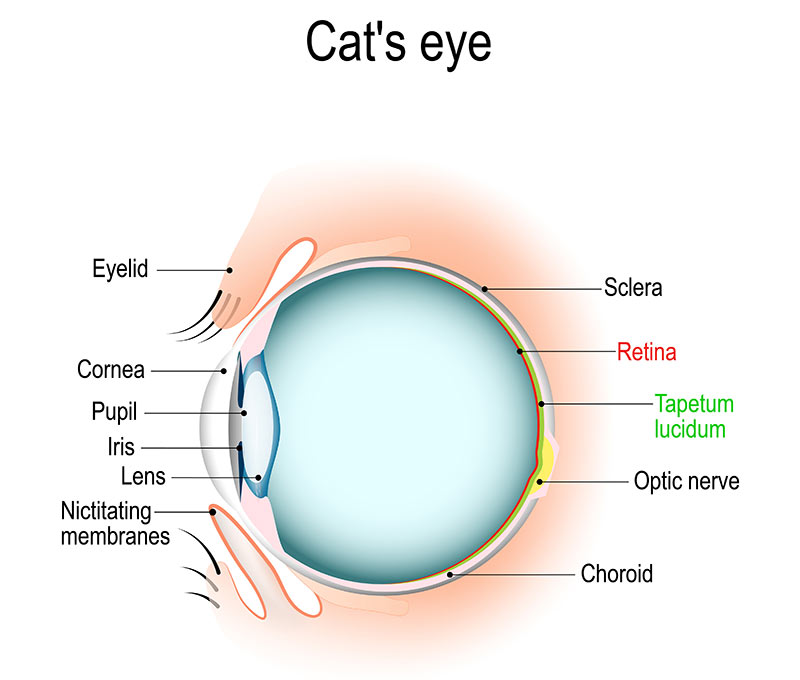
Cat feline eye anatomy diagram
Symptoms of keratoconjuctivis sicca in cats
Most cats with KCS will exhibit observable symptoms such as painful, red and irritated eyes. The most obvious warning sign is a chronic discharge of mucous that forms at the corner of the eyes.
Some of the common symptoms of dry eye in cats include:
- Excessive blinking
- Squinting
- Holding the eyes shut
- Dull appearance to the eyes
- Discharge of mucus from the eye
- Chronic redness
- Swollen conjunctival blood vessels
- Corneal ulcers
- Swelling of the eyelids
- Swelling of the tissue that lines the eyelids and surface of the eye (chemosis)
- Prominent third eyelids
- Sensitivity to light
- Appearance of a film over the eye
- A dry nose on the same side as the dry eye
- Pawing of the eyes
Causes of keratoconjuctivis sicca in cats
Dry eye in cats is a common eye disorder resulting from inadequate production of the aqueous portion of the tear film by the lacrimal gland. Some of the conditions that can impair the ability to produce adequate amounts of tear film, and thereby cause dry eye syndrome, include:
- Infection of the eye with feline herpesvirus
- Chronic inflammation of the conjunctiva
- A rare side effect of certain medications (such as sulfonamides)
- Removal of the third eyelid
- Trauma to the tear glands
- Certain neurological disorders
- Immune-mediated diseases that cause inflammation of the tear producing glands
- Nervous system effects of an inner ear infection
- Hypothyroidism
- Infections of the lacrimal glands
- Loss of nerve impulses to the lacrimal gland
Cats may suffer from KCS at any age, and all cat breeds are susceptible to the condition. It is possible that females are more predisposed to the condition than males. The disease may affect one or both eyes.
How is keratoconjuctivis sicca diagnosed in cats?
It is essential to consult a veterinarian if a cat has persistent discharge and redness of the eye or eyes. With early diagnosis, the long-term prognosis for vision is much better than when diagnosis occurs in a late stage of the disease.
Diagnosis is based on medical history, clinical signs and decreased tear production tests. There are other eye diseases that may resemble KCS in cats. It is important that an accurate diagnosis is made early in the disease because the treatments vary depending upon the eye disease present.
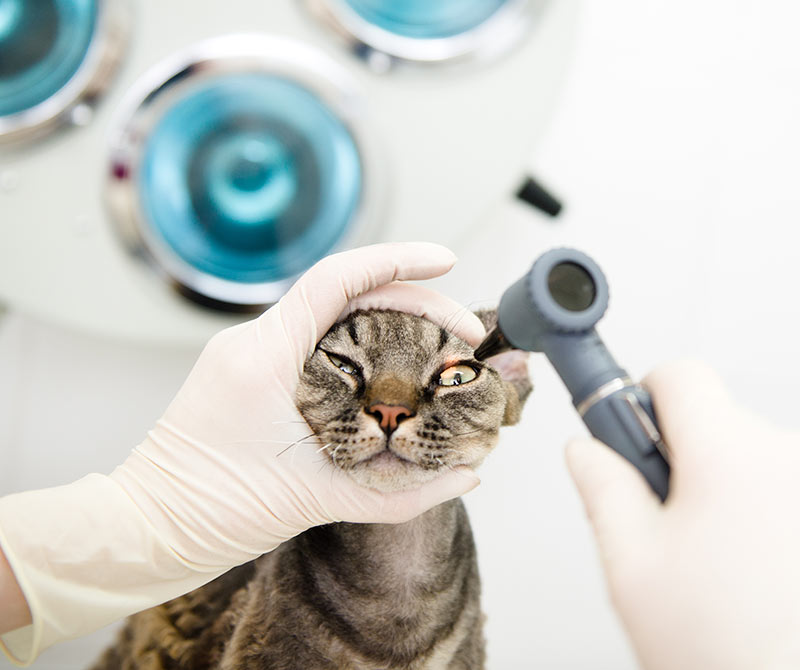
Medical history and physical examination:
In order to diagnose the cause of KCS, a thorough physical examination is performed, taking into account the background history of symptoms and possible incidents that might have led to the condition. KCS is confirmed by examination of the eye. An ophthalmological exam will assess the interior of the eye and reveal the degree of cloudiness and scarring of the cornea.
The Schirmer tear test (STT):
The most common tear production test is the Schirmer tear test (STT). This simple test uses a special wicking paper to determine the volume of watery tears produced by the eyes within a one-minute period. A low value of tear production is indicative of KCS.
Additional diagnostic tests that may be performed include:
- Corneal staining with fluorescein dye to check for corneal ulcers
- Intraocular pressure (IOP) to determine if glaucoma is present
- Tear duct examination or flushing to ensure normal tear drainage
- Culture of aqueous fluid sample for bacterial infection
Prognosis
KCS is not a life-threatening condition; however, it causes severe pain and irritation to the affected eye and if left untreated, can permanently impair vision. With early diagnosis and ongoing treatment, prognosis is usually good, and affected cats can usually live without pain.
If the condition is diagnosed late in the course of the disease, it is probable that protective layers of the cornea have been lost and extensive corneal scarring has developed. Where the cornea is scratched and scarred, painful corneal ulcerations can develop, and blindness may eventually occur. KCS is an especially painful condition, and cats with this illness may also suffer from depression and irritability as a result of their pain.
Treatment for keratoconjuctivis sicca in cats
The treatment of KCS has two objectives: to stimulate tear production and to replace tear film, thereby protecting the cornea. It is essential that the treatment plan is carefully followed to maximise the likelihood of a successful outcome. Once corneal scarring has developed, there is little that can be done to reverse it.
Non-surgical treatment of KCS:
In mild to moderate cases of dry eye in cats, medications, usually in the form of eye drops, can be used to treat the condition. However, in severe cases of KCS, eye drops may need to be applied almost hourly, which many cat owners find very difficult to maintain. These medications increase natural tear production and decrease inflammation and irritation to the eye, and may include the following:
- Lubricating eye drops to stimulate tear production are generally very safe; most cats improve dramatically with their consistent use.
- Tear film replacement drops (artificial tears) provide additional lubrication in order to keep the cornea moist and healthy, especially during the initial phase of treatment.
- Antibiotic eye drops may be used for a short period to clear any existing infection or bacterial overgrowth.
- Mucolytic eye drops, which help to dissolve the thick mucosal layer on the eyes, will reduce scratching on the cornea and increase the effectiveness of the other eye drops that are administered.
- Supportive immune therapies where KCS is caused by chronic feline herpesvirus; treatment includes antiviral medications, nutritional support, and reduction of stress in the environment.
- Topical anti-inflammatory medications to reduce inflammation and corneal scarring.
- Gently cleaning the eyes several times a day with a warm, wet washcloth may help stimulate tear film production.
- Other medications may be prescribed depending on the underlying diseases that have brought on the dry eye.
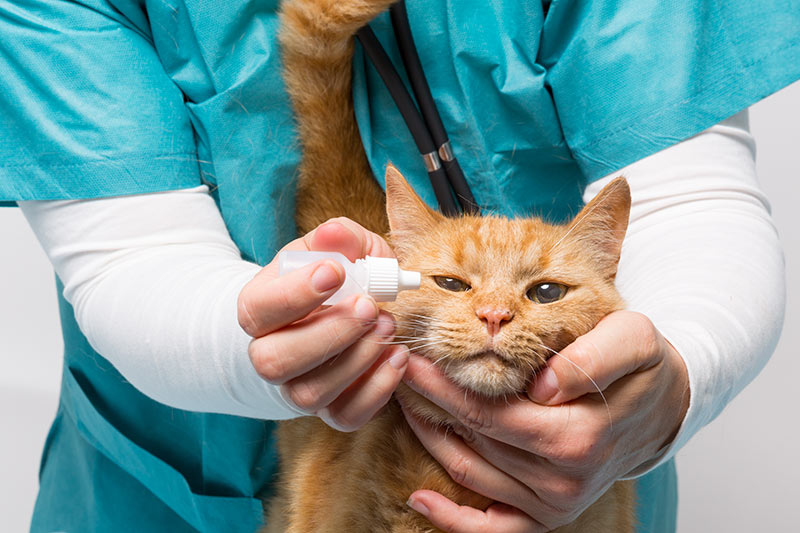
Surgical Treatment of KCS in cats:
Some cats with KCS do not respond well to medication, while severe cases may not be treatable with eye drop therapy alone. In rare cases, a surgical procedure known as parotid duct transplantation may be performed.
Parotid duct transplantation surgery entails redirecting a salivary duct from the mouth to the eye so that saliva substitutes for tears. The procedure has significant risks and carries the possibility of future complications, so it is usually only performed as a last resort, after an intense effort has been made to treat the condition with medication.
On-going care:
Non-surgical treatment may take weeks to months to resolve the condition, or depending on the cause of the condition, may continue for the cat’s lifetime. Determined application of medications for the entire duration is essential for the cat’s comfort, as well as to preserve its vision.
Cleaning the cat’s eyes before administering the medication is vital, in addition to keeping the eyes clean and free of dried discharge. A warm compress applied to the eye for a few minutes may make it easier to remove any discharge, and/or the eye may be carefully rinsed with an irrigating eye solution.
Regular follow-up visits to the veterinarian will be necessary to monitor response and progress. The Schirmer tear test will probably be performed again four to six weeks after initiating medication to evaluate its effectiveness.
Monitor the eye for changes such as increased discharge, squinting or redness, or signs such as rubbing or scratching at the eye. Consult your veterinarian immediately if this occurs.
In a nutshell
Keratoconjunctivitis sicca (KCS), more commonly known as dry eye, is a condition of decreased tear production leading to inflammation of the cornea and conjunctiva. It is a painful and uncomfortable condition; in severe cases, the eye becomes chronically inflamed and scarring of the cornea can lead to impaired vision.
Symptoms of KCS in cats include squinting, blinking excessively or holding the eyes shut. There may be a thick, mucoid discharge and corneal ulceration is often present. Depending on the underlying cause, the condition may require life-long medical care. The most common cause of dry eye in cats is an infection of feline herpesvirus.
While KCS is difficult to prevent, early treatment is crucial. Treatment typically entails the application of various topical eye drops; surgery is a last resort option. If left untreated, blindness can occur; however, most cats with dry eye have a good prognosis and can live without pain if medications are diligently administered.
More information
https://www.medvetforpets.com/keratoconjunctivitis-sicca-kcs-dry-eye-dogs-cats/
https://vcahospitals.com/know-your-pet/keratoconjunctivitis-sicca-kcs-or-dry-eye-in-cats
https://www.petmd.com/cat/conditions/eyes/c_ct_keratoconjunctivitis_sicca
https://www.petwave.com/Cats/Health/Dry-Eye.aspx
https://www.petplace.com/article/cats/pet-health/keratoconjunctivitis-sicca-kcs-in-cats/


